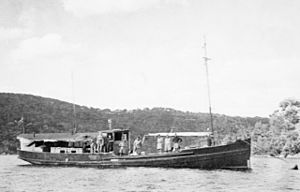MV Krait facts for kids

Krait in Broken Bay during World War II
|
|
Quick facts for kids History |
|
|---|---|
| Name | MV Krait |
| Captured | 1941 |
| Fate | Museum ship 1985 |
| General characteristics | |
| Tonnage | 68 gross tons |
| Length | 21.33 metres (70.0 ft) |
| Beam | 3.35 metres (11.0 ft) |
| Draught | 1.5 metres (4.9 ft) |
| Propulsion | Gardner 6LW diesel |
| Range | 8,000 miles (13,000 km) |
The MV Krait is a wooden boat famous for its role in World War II. It was used by the Z Special Unit (Z Force) from Australia. This special unit carried out a secret raid against Japanese ships. The raid happened in Singapore Harbour and was called Operation Jaywick.
Today, the MV Krait is on display. You can see it at the Australian National Maritime Museum (ANMM) in Sydney.
Contents
The Krait's Story
Early Days and Rescue Missions
The Krait was first a Japanese fishing boat. It was based in Singapore and named Kofuku Maru. When World War II began, Allied forces took control of the ship. They used it to rescue more than 1,100 people. These people were from ships that had been sunk near Sumatra.
The boat then traveled to Australia in 1942. It passed through Sri Lanka and India on its journey. Once in Australia, the ship was given to the Australian military. They renamed it Krait after a small but very dangerous snake.
Operation Jaywick
In September 1943, the Krait played a big part in a secret mission. It carried members of the Z Special Unit to Singapore. There, the team successfully attacked the city's harbor. They managed to sink seven Japanese ships. The Krait then returned safely to Australia in October.
The Australian military continued to use the Krait throughout the war. It was even present when the Japanese forces surrendered on Ambon in September 1945.
Post-War Missions and a Special Mascot
After the war, the Krait was used for intelligence missions. It traveled to various islands in the area. These islands included Buru, Aru, Ceram, Banda, and Saparua. During these trips, the boat carried Japanese prisoners. It also transported army survey teams and a naval intelligence officer.
While at Ambon, the boat gained a special friend. A monkey joined the crew as a mascot. He was named Peter and had lost his tail. Peter stayed with the crew until the Krait's service ended.
Becoming a Memorial
The Krait was later towed to Morotai. From there, it sailed to Labuan, where it was sold. The British Borneo Company bought the ship. Able Seaman Robert Harry Easom, from Perth, kept the ship's flag as a souvenir. This flag is now on display at the Australian War Memorial in Canberra.
After its sale, the Krait worked off Borneo. In 1964, it was bought to be an Australian Royal Volunteer Coastal Patrol vessel. On Anzac Day 1964, the Krait was officially made a war memorial. The governor of NSW dedicated it. A special plaque was placed on its wheelhouse.
In 1985, the Australian War Memorial acquired the Krait. They then lent it to the Australian National Maritime Museum. The Krait has been on public display there since 1988.
Restoration and Legacy
Plans for restoring the Krait began in 2015. This important work started in 2017.
Because of the Krait's success in Operation Jaywick, Australian Commando Unit vessels have a tradition. They often use the names of venomous snakes. This tradition continues today with boats like Red Viper and Coral Snake.
Affiliations
- TS Krait, Australian Navy Cadets
Images for kids




